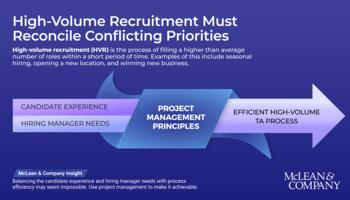Book a call with an analyst to define focused outcomes, determine the required jobs, and design and implement a customized TA structure. Understand how:
- Redesigning the TA structure is not a simple decision and there is no universal TA structure or formula. Given that there are so many structure choices and factors to evaluate, organizations risk having a structure that is not aligned with the hiring landscape, the organization’s needs, or its strategic objectives.
- Misaligned structures result in negative consequences for the TA function and the organization, such as talent acquisition process inefficiencies, team member burnout, lost productivity, decreased candidate satisfaction, and missed opportunities.
- Stakeholders are often resistant to structural redesigns due to the negative stigma surrounding "restructuring.”
Need Extra Help?
Speak With An Analyst.
- Get on-demand project support
- Get advice, coaching, and insight at key project milestones
- Go through a Guided Implementation to help you get through your project

Our Advice
Critical Insight
- There is no universal Talent Acquisition (TA) structure; creating a customized and adaptable TA structure that aligns with the organization’s goals and supports the talent acquisition strategy will be most effective as internal and external factors continue to shift.
Impact and Result
- Understand the TA process and identify inefficiencies, root causes, and gaps to avoid carrying them into the new structure.
- Adapt the TA structure to the TA landscape and tailor it to the organization’s strategic objectives by preserving strengths, resolving challenge areas, and addressing structural implications.
- Engage stakeholders in the redesign. Use stakeholder feedback to inform design principles, and keep stakeholders involved in the process to ensure buy-in.
- Create a TA structure that supports strategy delivery and focuses on the organization’s future needs to allow for scalability and adaptability, reducing the need for frequent structure redesigns.
Workshop: Redesign the Talent Acquisition Structure
Workshops offer an easy way to accelerate your project. If you are unable to do the project yourself, and a Guided Implementation isn't enough, we offer low-cost delivery of our project workshops. We take you through every phase of your project and ensure that you have a roadmap in place to complete your project successfully.
Module 1: Define the desired outcomes of the TA structure
The Purpose
- Identify strengths, challenge areas, and structural implications to inform the redesign. Establish design principles, goals, and metrics to guide the redesign.
Key Benefits Achieved
Informed and defined design principles to guide the TA structure redesign.
Activities
Outputs
Identify strengths, challenge areas, and structural implications for the new TA structure.
- Defined strengths, challenges, and structural implications.
Finalize goals and establish design principles.
- Goals to track success and five to ten design principles.
Module 2: Identify the level of centralization of TA activities
The Purpose
Establish how TA activities will be completed and define the level of centralization.
Key Benefits Achieved
Selected metrics and defined level of centralization for the TA structure.
Activities
Outputs
Select metrics to track progress toward goals.
- Metrics to track the impact.
Decide which activities will be completed by TA.
- TA team activities and responsibilities.
Determine how each TA activity will be completed (centralized COE or decentralized by organizational unit).
- Level of centralization for the TA team.
Module 3: Create TA activity groups to inform required jobs.
The Purpose
Group TA activities to identify jobs that will be responsible for completion of the assigned activity group.
Key Benefits Achieved
TA activities grouped to inform required jobs.
Activities
Outputs
Evaluate the workload for each TA activity given their required time, effort, and volume.
- TA activity cards with identified workload amount.
Use activity cards to group similar TA activities.
- TA activity groups to inform required jobs.
Module 4: Determine required TA jobs
The Purpose
Finalize jobs and plan for workload fluctuations.
Key Benefits Achieved
Balanced jobs and an adaptable TA structure.
Activities
Outputs
Select jobs responsible for each activity grouping.
- Required jobs.
Balance selected jobs and activities.
Document strategies to adapt to workload fluctuations.
- Workload fluctuation strategies.
Module 5: Design the TA structure
The Purpose
Estimate headcount requirements to determine the quantity of positions required for each job.
Key Benefits Achieved
Defined headcount, finalized reporting structure, and completed presentation to provide to stakeholders.
Activities
Outputs
Determine the required quantity of positions for each job.
- Estimated TA headcount.
Create an updated reporting structure.
- Reporting relationships.
Complete the TA Structure Presentation Template.
- TA Structure Presentation.
Identify next steps.

 Create a Talent Acquisition Strategy
Create a Talent Acquisition Strategy
 Increase the Efficiency of the Talent Acquisition Process
Increase the Efficiency of the Talent Acquisition Process
 Redesign the Candidate Experience
Redesign the Candidate Experience
 Streamline the Internal Hiring Process
Streamline the Internal Hiring Process
 Plan for High-Volume Recruiting
Plan for High-Volume Recruiting
 Determine the Right Recruitment Process Outsourcing Solution
Determine the Right Recruitment Process Outsourcing Solution
 Redesign the Talent Acquisition Structure
Redesign the Talent Acquisition Structure